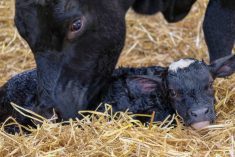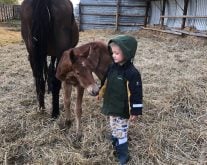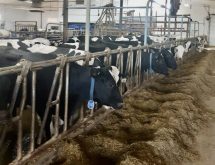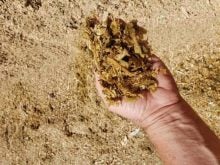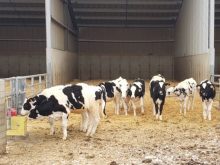As a young dairy nutritionist years ago, university research taught me that once a lactation cycle is completed, the dairy cow should be dried off, dry-treated and put onto a 60-day dry cow feeding program — an initial faraway stage of 40 days, and followed by a 20/21-day close-up stage.
As a result many metabolic and physical problems are also avoided, as she gives birth to a healthier calf and it helps her prepare for her next lactation. That is why I still advocate these basic principles in my consulting work.
Read Also

Harvest wraps up and fall work begins
At the Eppich famly ranch in western Saskatchewan, the fall harvest was successful with few breakdowns, cows and calves have been sorted and a new tractor has arrived
I believe a good 40-day faraway feeding (and management) program should have three underlying objectives:
The program
1. Allow the udder to rest. During a 10-month lactation cycle there is a 50 per cent decline in the number of secretory cells within the mammary gland. During the faraway dry period, the number of secretory cells is restored to its full complement needed in the next lactation. However, the extent of milk-cell rejuvenation is complete by 25 days into the dry period (University of Maryland).
2. Restore organ health. The high-forage diet allows the cow’s rumen to rebound, regrowth of the essential papillae tissue, restoration of healthy pH levels and resets muscle tone. All of these are compromised by feeding high-energy (starch) lactation diets. The 40-day faraway program also allows the cow’s liver some time to recover from metabolic problems such as ketosis and fatty liver syndrome.
3. Restore hormonal and immune function. Lactating cows milking at high production levels have a lot of hormonal changes going on that affects natural dry matter intake of feed, feed digestion/metabolism, bodyfat and bone mobilization as well as fertility. The 40-day program also helps restore the cows’ immune function, which is very active during lactation to combat mastitis and other infections.
Proper body condition
With these objectives, I also keep them in mind the cow’s immediate nutritional status after months of lactation. A dairy cow should be brought into dry period with a body condition score (BCS) at 3.0-3.5 (1 = thin, and 5 = fat). And it should be fed for the next 40 days (dovetails into the close-up feeding program) with a ration that either maintains optimum BCS or builds up thin=BCS cows until calving.
To maintain/build such optimum BCS in faraway dry cows as well as support their growing fetus (when 65-75 per cent of fetal growth occurs), a faraway dry cow diet should be made up of bulky good-quality grass-type forage by which the cow consumes 1.8-2.2 per cent of her bodyweight (DM basis).
On an absolute basis, this means the whole diet should supply about 14-16 Mcal of dietary energy (or TDN = 60-62 per cent), and 13-14 per cent crude protein. A dry cow premix ought to be provided to round-out these forages; 0.50 per cent calcium, 0.30 per cent phosphorus, 0.5 per cent salt and trace minerals (copper, zinc, selenium) and vitamins (A = 100,000, D = 3,000 and E = 1,000 iu/head). Lastly, 10 g per head per day of commercial yeast would be included.
Some dairy specialists advocate that cows really don’t need this seven-week period to prepare for lactation. They point out that many high milk-producing cows could produce more milk of significant economic benefit by allowing an extra 25 lactation days (325-day lactation cycle, instead of the standard 305 days), which is then offset by a new modified 30-35-day dry-cow program. But the results of university research performed on proposed short faraway dry cow periods have been mixed. Mature cows are largely unaffected while first-calf heifers have consistently reduced milk yields.
About 10 years ago a friend who milks 300 Holstein cows tried to reduce his faraway dry cow program by 10 days. After about a couple of months, he returned to his previous program. He discovered that many of his dairy cows often come into the dry period in a relatively thin body condition. On the new (shorter) program, they did not recover this bodyweight, as well as they did on the longer faraway program. He also speculated that his older program pushed the dry cows’ “reset button,” leading to better long-term cow herd longevity.




